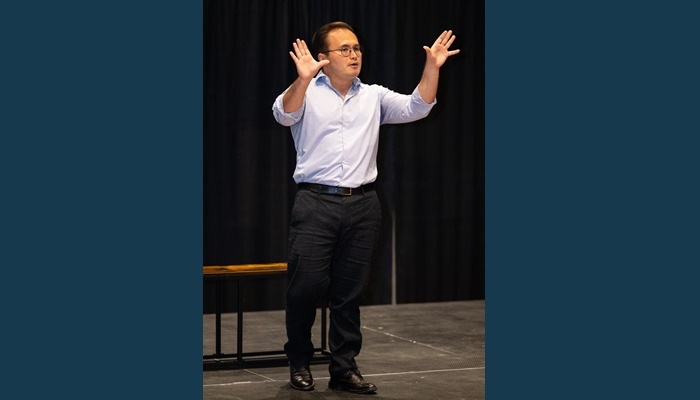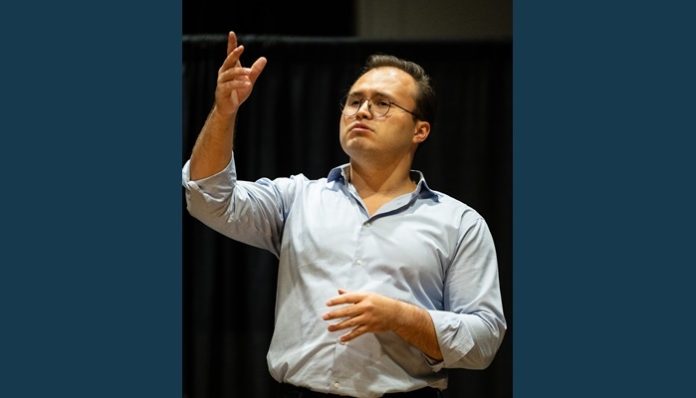SALT LAKE CITY, Utah, March 5, 2024 (Gephardt Daily) — Every now and then, a theater production comes along that is so exquisite that it makes you forget everything around you. For me, this last weekend, that was Voodoo Theatre Company’s “The Absolute Brightness of Leonard Pelkey,” playing at the Alliance Theater in Trolley Square for a two-week run that ends this Sunday, March 10.
I saw the show on possibly the most dramatic snow day of the year, and one could tell at the beginning that audience members were maybe a little bit frazzled by the weather, and the drive, and probably the myriad of stuff that was going on in their own heads. But the moment actor Alvaro Cortez entered the space, and began the 80-minute, one-man show, all the problems of the world just dropped away and for the duration, I was absolutely mesmerized by every single second.
Let’s rewind a little bit. The show, which was developed and first presented at the Dixon Place theater in New York in February 2015 and then was a sleeper hit Off-Broadway, was written and first performed by Celeste Lecesne, who was then known as James Lecesne, and who is a playwright, performer and activist. They co-founded the Trevor Project, a non-profit suicide prevention organization that provides 24/7 crisis support services, research, and advocacy for LGBTQ+ youth. This show was adapted from Lecesne’s 2008 young adult novel “Absolute Brightness.”
This is Voodoo Theatre’s third show. All have been produced in the Alliance’s main space. The company describes its mission as “striving to perform plays actors want to act in, and audiences want to see.” Its mission statement adds: “We aim to engage and enrich our community through thought-provoking, emotional, and thrilling produced plays.” And in this instance, it has achieved that goal, in spades.

The show’s primary narrator is Chuck DeSantis, a hardened Jersey detective. “The dark side is my beat,” he tells us. He’s recalling an incident that happened a decade earlier: One day, a local hair salon owner by the name of Ellen Hertle came to the station to report the disappearance of 14-year-old Leonard Pelkey, whom she says is her nephew, although the connection is technically that he’s her brother’s ex-girlfriend’s son, and who had at that time been missing for almost 20 hours.
Soon after, Ellen suddenly remembers that when Leonard disappeared he was wearing a pair of rainbow-hued platform sneakers that he’d made himself by gluing colored flip-flops to the bottom of Converse high-tops. The case takes a bleak turn when Gloria Salzano, a mob widow whose home is on the edge of a local lake, sees one of Leonard’s distinctive shoes floating in the water. Not long after, his body is found and a homicide investigation gets underway.
A picture is then painted of Leonard by the townspeople whose life he has changed and made better. Cortez plays a total of nine characters, from Buddy Howard, the twee English proprietor of a dance-and-drama school who describes the boy in this manner: “I don’t think I’ve ever met a child who could express himself so thoroughly with jazz hands,” to Otto Beckerman, a local clock repair shop owner where Leonard hid from the bullies who would taunt him, which was the location he was last seen.
We also learn that Leonard loved to give Ellen’s customers advice on their hairdos and urged them to invest in little black dresses, with the theory that having such a dress would conjure the occasion to wear it. Though the other characters celebrate Leonard, some of them also recall encouraging him to be less himself. Marion Tochterman, a patron of Ellen’s salon, says: “I tried to warn him. Tone it down honey, I said to him. The nail polish, the mascara — maybe not so much. He claimed he was just being himself. All right, fine, but do you have to be so much yourself? He told me if he stopped being himself the terrorists would win. How do you argue with a kid like that?”

A show about the brutal murder of a gay teenager does not sound like a night at the theater that is also joyful, humorous, and uplifting, but that’s the brilliance of this piece; it’s a celebration of a luminous force of nature whose magic is only truly felt once he is gone. The teenager becomes an unexpected inspiration as the town’s citizens question how they live, who they love, and what they leave behind.
I loved every aspect of the play from beginning to end. Every character and every location, thanks to the absolute brilliance of Lecesne’s writing paired with Cortez’ beautifully nuanced performance and Patrick C. Kibbie’s smooth direction, comes to life with vivid brilliance. Cortez, who graduated from Westminster College’s BFA theater program in 2020, does not miss one beat. He has us in the palm of his hand from the moment he meanders through the audience to begin the piece, to the last few moments, which wrap the story up with the most beautiful rainbow bow. He and Kibbie, along with assistant director Jack Cobabe, ensure that every moment is dug into and mined for all its’ nuances. One could actually see the audience craning forward, eager not to miss one single second. And yet Cortez is also not trying too hard; he creates each character from the inside out, with small but absolutely specific nuances to differentiate them.
Cortez’ performance is only highlighted further by the very simple staging and production values. The set consists of one bench, on an otherwise bare stage surrounded by drapes. In a somewhat Brechtian touch, the stage and the theater itself is also used to depict the Buddy Howard School of Drama and Dance that is described in the show. In the script, a handful of props and projections are described, but there are none in this production, which I enjoyed even more because it helps us create pictures in our own heads. I could see the rainbow boots, I could see the town, I could see the lake. The costume design consists of a pair of dark trousers and a shirt for Cortez. The lighting and sound designs are clean, spare and simple; the lighting by Emilio Casillas helps us to differentiate the characters with subtle changes as the various townsfolk are introduced. The sound design, by Melanie Kamauu, is also uncomplicated, but helps to suggest different locations as well as the passing of time.

It’s a brilliant touch, in my opinion, that we never meet the title character of the play. Leonard Pelkey exists in a vacuum; he’s ethereal, like stardust, an amalgamation of what others have said about him and how he’s made them whole. The show had echoes of Moisés Kaufman’s “The Laramie Project” for me, but unlike Matthew Shepard, Leonard Pelkey was not a real person, but perhaps a composite of all of the young people who have died as a result of hate crimes. Fairly recently, I drove with my husband and mother through Laramie, Wyoming, and it’s utterly tragic that every split-rail fence we passed, I thought of Shepard, beaten, tied to a fence and left to die with blood covering his face except for the tracks that his tears had left. That’s the first thought most of us have of Shepard, who, by the way, was a first-year political science major at the University of Wyoming in Laramie who spoke German and Italian, and who was interested in theater. And it’s a credit to Lecesne that the image we take away of Leonard Pelkey is him dressed in his green and pink Capri pants and rainbow high-tops, resplendent in mascara and nail polish and wearing the wings he insisted he must have to play Ariel, the fairy character in Shakespeare’s “The Tempest.” The play makes sure that in our minds, Leonard Pelkey is not dead, but very much alive and celebrated for his differences for ever after.
“The Absolute Brightness of Leonard Pelkey” plays at the Alliance Theater at Trolley Square on Friday, March 8 and Saturday, March 9, at 7:30 p.m., with a Saturday matinee at 2 p.m. and a Sunday show on March 10 at 6 p.m. For tickets and information on Voodoo Theatre Company’s next show, “People, Places & Things,” by Duncan MacMillan, coming in July, click here.







